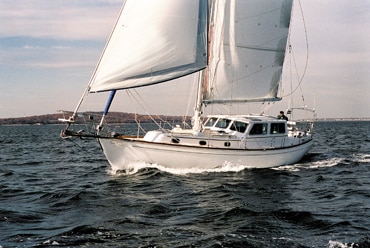
January and New England are hardly the time and place to go for a casual spin on the water, but when better to test the efficacy of a pilothouse sailboat? In the middle of last year’s cold snowy winter, designer and builder Walt Schulz launched the prototype of his new Shannon Pilot 43. A blanket of white and a glaze of ice contrasted starkly with the cobalt blue of Rhode Island’s Narragansett Bay under the sun’s frosty light.
Using the shapely, well-proven Shannon 43 hull, Schulz has done a remarkably good job of blending in the lines of the pilothouse, a structure that all too often ends up looking like an add-on bunker aboard a vessel this size. By keeping most of the commodious cockpit virtually identical to that aboard the original sloop, the house does not encroach too far aft, so preserving the boat’s pleasing traditional lines.
Under way, the 71-horsepower Westerbeke (a 75-horsepower Yanmar is available alternatively, owner’s choice) spinning a three-blader provides responsive thrust, quick stopping power and positive reverse control. Fed by two 71-gallon stainless steel fuel tanks, the auxiliary is happy at a cruising speed of about seven knots for up to 500 miles. The longish fin with its cutaway forefoot and centerboard reduces draft to 4’10″ and allows tight turns of a boat length and a half or so. A large, heavily built skeg protects the prop and rudder.
Winds were too light and fluky to obtain definitive performance data, but notwithstanding that the boat reached speeds of better than 3.5 knots at 35 degrees apparent in just 10 knots of breeze. On a reach she logged 2.5 knots in just five knots of breeze, and 4.5 in eight to 10. Despite having to raise the boom to accommodate the pilothouse, Schulz has actually increased the sail area to 1,193 square feet (with main, jib and flying jib), in part by utilizing a large crane at the masthead that allows an enhanced-roach fully battened mainsail. A sculpted jib boom, moved fore and aft with on-deck tackle, adjusts the foot tension of the inner masthead jib — you bring the clew aft for upwind work, then slide it toward the bow downwind to move the center of effort forward and enhance the sail’s offwind shape. This headsail is supplemented by a high-cut flying jib or a 140 percent genoa flown from the bowsprit.
Schulz calls the unorthodox, half-sloop half-cutter arrangement a “scutter” rig. It is designed to keep the sail plan forward to counteract weather helm in heavy conditions, and the experience of Schulz, his delivery crews and more than a few of his very satisfied globe-girdling owners indicates that the rig works as advertised.
Of course, the real job of a pilothouse boat is the protection it offers the crew. Inside the deck house, large windows provide solarium warmth even without ancillary heat. You get a good view of the jibs looking forward and you can monitor the mainsail through a strategically placed hatch above the inside helm.
The pilothouse provides a wonderful lounging and dining area. It steps down to a U-shaped galley opposite a guest cabin with twin single berths and its own head. A master cabin with a large double berth and an adjacent head nests forward. Everything below is finished to Shannon’s trademark high standards, which include sturdy yet meticulously rendered cabinet work, solid hardwood trim, teak and holly soles, and even cedar-lined lockers.
The Shannon construction facility in Bristol, Rhode Island, is an impressive outfit in which modern, state-of-the-art materials and building techniques are engaged with knowledge and enthusiasm. These boats are built to go offshore and they have a history of success doing so. The 43 features a hand-laid composite hull consisting of Corecell linear PVC foam and a complicated schedule of biaxial laminates and Kevlar aramid that varies according to the stress requirements of different parts of the boat; premium vinylester resins and an anti-osmotic isophthalic gel coat complete the recipe. The hull-deck joint is bonded chemically and then thru-bolted on eight-inch centers, with biaxial laminates backing the internal hull flange. Solid lead ballast is encapsulated and sealed within the fiberglass keel element. Hefty floor timbers and reinforcing stringers with extra 45×45-degree-bias biaxial strengthening rigidify the underbody. Tabbed structural bulkheads tie the hull and deck together. Even elements of the cabin furniture are fully bonded to the hull sides for added strength.
The list of standard equipment is impressive, including hot and cold pressure water, 184-gallon freshwater tankage, four 120-amp-hour gel-cell batteries, 110-volt dockside power, Seafrost refrigeration, Navtec rod rigging, Datamarine instrumentation, a substantial complement of safety gear and so on. Attention to detail in the selection of standard items and in their installation promotes easy long-term maintenance while reducing its likely need.
In short, any serious cruiser looking for shelter from the sun, wind, rain, fog or cold will find an attractive, well built friend in the Pilot 43. The yard encourages clients to visit for on-site inspections throughout the building process, and opportunities for customizing virtually any aspect of the boat are a given.
Shannon Pilot 43 Specifications:
LOA: 48’0″ (14.6 m.)
LOD: 43’10” (13.4 m.)
LWL: 36’9″ (11.2 m.)
Beam: 13’0″ (3.96 m.)
Draft (cb’d up): 4’10” (1.5 m.)
Draft: (cb’d dn): 8’7″ (2.6 m.)
Draft (fixed): 6’6″ (1.98 m.)
Ballast: 10,500 lbs. (4,763 kgs.)
Disp: 29,000 lbs. (13,154 kgs.)
Sail area: 1,193 sq.ft. (110.8 sq.m.)
Mast above water: 63’0″ (19.2 m.)
Ballast/Disp: .36
Disp/Length: 261
SA/Disp: 20.2
Fuel tankage: 100 gal. (378 ltr.)
Water tankage: 200 gal. (757 ltr.)
Auxiliary: 71-hp. Westerbeke W-71
Cabin headroom: 6’7″ (2.0 m.)
Designer: Walt Schulz
Base price: $554,000 sailaway
Shannon Yachts
19 Broad Common Rd.
Bristol, RI 02809
Phone: (401) 253-2441








